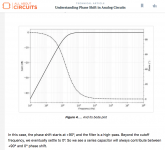Thanks Adason , you have pointed me in the right direction. Quite possibly I didn´t see the forest for the trees . Cheers
MalleMike,Please let me get back to the capacitor intended to protec the tweeters but without modifying the response of the above.
All I need to figure out how big it has to be not to cause any shift in phase above 1000 Hz for a load of 8Ohm
The larger the series capacitor value, the lower in frequency the 90 degree phase shift it introduces to the loudspeaker will be.
There is always a cost for "protection" ;^)
Using a 24dB per octave crossover (360 degrees of phase shift), the limited overlap region tends to hide an additional 90 degrees of phase shift..
Art
Attachments
Last edited:
Precisely so. And if the response function (level variation and phase shift, let alone acoustic offset) doesn’t matter to you, why all the fuss about a cap in series with the tweeter? You won’t get good (let alone perfect) acoustic summings anyway.Of course this does not compensate for the response curves of the drivers themselves . That is a different matter.
thanks for the info. I am aware of the fact. with an active xover of 3000Hz and 24 db/octave the tweeter is down 24 dB at 1500 HZ and 48 dB at 750 Hz . With an 8 Ohm tweeter and a series capacitor of 66uF which is a 6 dB high pass at 300 Hz at 600 Hz I will be in the region where there is 0 degrees phaseshift due to the cap . of course bigger will do even better.
The best choice I can find is a100uF100V capacitor from Mouser see :
https://www.mouser.es/ProductDetail/KEMET/R60EW61005000K?qs=lyRJTFulC0ZALh2o7uDGyQ==
They have a68uf90V but more expensive than this one .
I consider a cost of 15 dollars acceptable if on one side it protects my tweeter from DC , introduces no phase shift and is a lot more reliable than an electrolytic
The best choice I can find is a100uF100V capacitor from Mouser see :
https://www.mouser.es/ProductDetail/KEMET/R60EW61005000K?qs=lyRJTFulC0ZALh2o7uDGyQ==
They have a68uf90V but more expensive than this one .
I consider a cost of 15 dollars acceptable if on one side it protects my tweeter from DC , introduces no phase shift and is a lot more reliable than an electrolytic
I want to thank everybody for their respective contributions and let you know that I now have the necesary info and solution to my problem . Great , and cheers. Michael
( Any further development I will ,of course , let you know. )
( Any further development I will ,of course , let you know. )
I have some additional information as to why I am so insistent on the subject.
1.) the system is tri-amped with the amps for the Tweeter and Midrange having the same rail voltages as the bass amp , plus minus 50 volts backed by 20000 uf . Anything going wrong there will INSTANTLY blow the voice-coil of the tweeter , and that of the midrange almost as fast. So one cannot risk DC ever reaching those .
On the other hand any clipping will first occur on the bass but will not influence the midrange and treble amps just as any possible clipping on the midrange will not influence the tweeter. The reasons for going to all these troubles are to eliminate all the inconviences and disadvantages of passive crossovers , and to allow for much better dynamic ranges for the individual speakers. WITHOUT adding others in their stead .
What I achieve by tri-amping is not higher power of the system as the bass still is limited to 100 W clean signal . It is a good headroom for the midrange and a very good one for the tweeter , among many other advantages and improvements .
But I don´t want a " DC-timebomb" wating to happen to vintage ribbon-tweeters .
Those truly interested please read these articles from Elliot sound systems :
Power Amplifier Clipping and :
Why Do Tweeters Blow When Amplifiers Distort?
The man explains it a lot better than I ever could .
1.) the system is tri-amped with the amps for the Tweeter and Midrange having the same rail voltages as the bass amp , plus minus 50 volts backed by 20000 uf . Anything going wrong there will INSTANTLY blow the voice-coil of the tweeter , and that of the midrange almost as fast. So one cannot risk DC ever reaching those .
On the other hand any clipping will first occur on the bass but will not influence the midrange and treble amps just as any possible clipping on the midrange will not influence the tweeter. The reasons for going to all these troubles are to eliminate all the inconviences and disadvantages of passive crossovers , and to allow for much better dynamic ranges for the individual speakers. WITHOUT adding others in their stead .
What I achieve by tri-amping is not higher power of the system as the bass still is limited to 100 W clean signal . It is a good headroom for the midrange and a very good one for the tweeter , among many other advantages and improvements .
But I don´t want a " DC-timebomb" wating to happen to vintage ribbon-tweeters .
Those truly interested please read these articles from Elliot sound systems :
Power Amplifier Clipping and :
Why Do Tweeters Blow When Amplifiers Distort?
The man explains it a lot better than I ever could .
Last edited:
